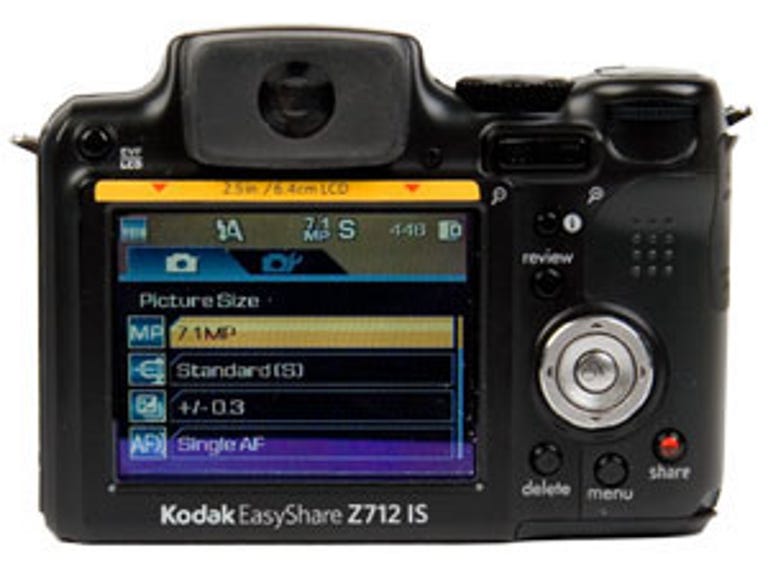 Why You Can Trust CNET
Why You Can Trust CNET Kodak EasyShare Z712 IS review: Kodak EasyShare Z712 IS
The Kodak EasyShare Z712 IS looks like a sawn-off SLR. It's a flexible camera, considering its 12x optical zoom lens, which makes for impressive image quality
The Kodak EasyShare Z712 IS is a 7.1-megapixel superzoom digital camera. It is available now for around £180. Quite a respectable price tag, as it includes a number of features associated with SLR cameras but all in a lightweight frame closer to compact size.
The Good
The Bad
The Bottom Line
The Z712 IS' biggest draw is a giant 12x optical zoom but is it the best of both worlds or neither fish nor fowl?
Design
The Z712 IS looks like a sawn-off SLR, and has several features you might associate with dSLRs. It has an electronic viewfinder, which is unfortunately only as clear and bright as the screen resolution allows. This makes precise manual focusing a bit tricky but you do have an automatic focus that gives you a cool green grid when it locks on.
The viewfinder also takes some getting used to as there's some motion blur and it's quite small. We would also prefer a square viewfinder. All the screen functions, such as the menus, are replicated in the viewfinder should you know the button layout well enough to keep the camera at your eye to change settings.

Images can be played back through the viewfinder, should you want to, as well as on the 64mm (2.5-inch) screen. Printing and emailing pictures is made easy by Kodak's signature EasyShare discrete sharing button.
Other high-end features include a pop-up flash, full manual control of exposure and focus, and a Schneider-Kreuznach Variogon lens. A lens cap would be nice, as the lens stays uncovered when the camera is off. A bag or pouch of some kind would be useful, too, especially as superzooms are not easily pocketable.
Images are loaded on to SD cards, stored in a neat double-lidded slot with the battery. The blocky shape keeps the overall form reasonably compact despite the length of the lens.
The Z712 IS is light at 300g but really easy to hold, thanks to a chunky grip at the side. There are two lugs for a proper neck-strap rather than a compact-style wrist loop. Meanwhile, the plastic body feels creaky, and you can feel the camera thinking whenever it does anything.
Features
Although the 12x zoom -- with its 35mm equivalent
maximum of 430mm -- is impressive, zooming in and out is something of a
chore. The screen loses focus entirely when the zoom is in motion.
Zooming is controlled by a rocker switch, which isn't as responsive or as fast as we'd like, and moves in annoying increments. We'd prefer it to be controlled by an SLR-style manual ring on the lens itself but these are rare on superzooms not made by Panasonic. The manual focus is similarly unwieldy, controlled by the click-pad and somehow even less fluid than the zoom rocker.
The 'IS' in Z712 IS stands for 'image stabilisation', essential on cameras with such long lenses that magnify camera shake. This gives you two or three stops of exposure when pushing the telephoto to its limit.
One feature we'd like to see more often is an orientation sensor. This senses whether you are holding the camera in portrait or landscape position and rotates the image accordingly. While this clever feature cuts down on your image processing time, it does unfortunately shrink the images you see on the screen in playback mode, making reviewing tricky.
Another interesting feature is a panoramic mode. This allows you to take a number of pictures and then have the camera stitch them together. It takes a while to process the final image but the results are impressive -- ideal for holiday landscapes.
Menus are simple and easy to navigate, as most of the functions are controlled by dedicated buttons. This gives a satisfying sense of control, cutting down on the menu-sifting inherent in compact design. Shooting options are easily selected and altered with a pleasingly zippy thumb wheel on the camera's shoulder.
Performance
The Z712 IS is faster than most superzooms, which still isn't
exactly blistering. When you trip the spring-loaded power switch, it
fires up in a gratifying 1.5 seconds. The autofocus is acceptably quick
to lock on to subjects but after all this, the camera is let down by its
processor. After four or five shots the Z712 IS tends to lock up for a
couple of seconds while buffering pictures. Even in continuous mode
there are regular pauses to process.
Image quality
Starting at ISO 64 is good, as images are sharp and entirely
noise-free at this setting. Noise begins to show up at ISO 400. Images
are substandard at ISO 800 and unusable at ISO 1,600. Image quality at
the lower speeds is excellent, with the Schneider-Kreuznach Variogon
lens showing hardly no distortion or softening at the corners.
The portrait preset was disappointing, softening up images and
showing pale colours. This was especially a problem when image
compression adds artefacts to the picture as it tries to squash file
sizes. The automatic mode is a better bet.
The Kodak EasyShare Z712 IS is a flexible, well-specced camera in a highly portable body. Image quality can be excellent, thanks to a great lens, but there are a few gripes. Overzealous compression and slow processing, along with some clunky controls and a poor viewfinder, make this camera less fun than it should be.
Nevertheless, for less than £200 there is plenty to like about a camera with a zoom this size and decent image stabilisation.
Edited by Jason Jenkins
Additional editing by Shannon Doubleday


